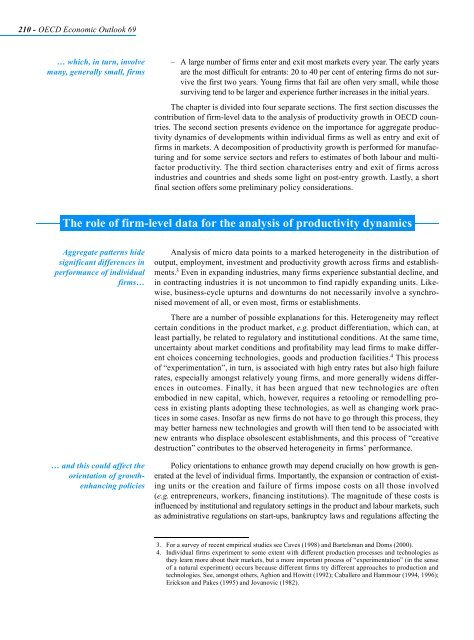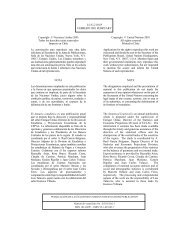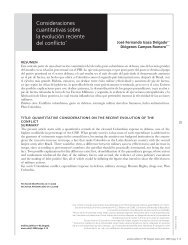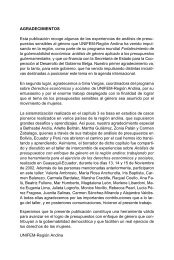OECD Economic Outlook 69 - Biblioteca Hegoa
OECD Economic Outlook 69 - Biblioteca Hegoa
OECD Economic Outlook 69 - Biblioteca Hegoa
You also want an ePaper? Increase the reach of your titles
YUMPU automatically turns print PDFs into web optimized ePapers that Google loves.
210 - <strong>OECD</strong> <strong>Economic</strong> <strong>Outlook</strong> <strong>69</strong><br />
… which, in turn, involve<br />
many, generally small, firms<br />
Aggregate patterns hide<br />
significant differences in<br />
performance of individual<br />
firms…<br />
– A large number of firms enter and exit most markets every year. The early years<br />
are the most difficult for entrants: 20 to 40 per cent of entering firms do not survive<br />
the first two years. Young firms that fail are often very small, while those<br />
surviving tend to be larger and experience further increases in the initial years.<br />
The chapter is divided into four separate sections. The first section discusses the<br />
contribution of firm-level data to the analysis of productivity growth in <strong>OECD</strong> countries.<br />
The second section presents evidence on the importance for aggregate productivity<br />
dynamics of developments within individual firms as well as entry and exit of<br />
firms in markets. A decomposition of productivity growth is performed for manufacturing<br />
and for some service sectors and refers to estimates of both labour and multifactor<br />
productivity. The third section characterises entry and exit of firms across<br />
industries and countries and sheds some light on post-entry growth. Lastly, a short<br />
final section offers some preliminary policy considerations.<br />
The role of firm-level data for the analysis of productivity dynamics<br />
… and this could affect the<br />
orientation of growthenhancing<br />
policies<br />
Analysis of micro data points to a marked heterogeneity in the distribution of<br />
output, employment, investment and productivity growth across firms and establishments.<br />
3 Even in expanding industries, many firms experience substantial decline, and<br />
in contracting industries it is not uncommon to find rapidly expanding units. Likewise,<br />
business-cycle upturns and downturns do not necessarily involve a synchronised<br />
movement of all, or even most, firms or establishments.<br />
There are a number of possible explanations for this. Heterogeneity may reflect<br />
certain conditions in the product market, e.g. product differentiation, which can, at<br />
least partially, be related to regulatory and institutional conditions. At the same time,<br />
uncertainty about market conditions and profitability may lead firms to make different<br />
choices concerning technologies, goods and production facilities. 4 This process<br />
of “experimentation”, in turn, is associated with high entry rates but also high failure<br />
rates, especially amongst relatively young firms, and more generally widens differences<br />
in outcomes. Finally, it has been argued that new technologies are often<br />
embodied in new capital, which, however, requires a retooling or remodelling process<br />
in existing plants adopting these technologies, as well as changing work practices<br />
in some cases. Insofar as new firms do not have to go through this process, they<br />
may better harness new technologies and growth will then tend to be associated with<br />
new entrants who displace obsolescent establishments, and this process of “creative<br />
destruction” contributes to the observed heterogeneity in firms’ performance.<br />
Policy orientations to enhance growth may depend crucially on how growth is generated<br />
at the level of individual firms. Importantly, the expansion or contraction of existing<br />
units or the creation and failure of firms impose costs on all those involved<br />
(e.g. entrepreneurs, workers, financing institutions). The magnitude of these costs is<br />
influenced by institutional and regulatory settings in the product and labour markets, such<br />
as administrative regulations on start-ups, bankruptcy laws and regulations affecting the<br />
3. For a survey of recent empirical studies see Caves (1998) and Bartelsman and Doms (2000).<br />
4. Individual firms experiment to some extent with different production processes and technologies as<br />
they learn more about their markets, but a more important process of “experimentation” (in the sense<br />
of a natural experiment) occurs because different firms try different approaches to production and<br />
technologies. See, amongst others, Aghion and Howitt (1992); Caballero and Hammour (1994, 1996);<br />
Erickson and Pakes (1995) and Jovanovic (1982).
















